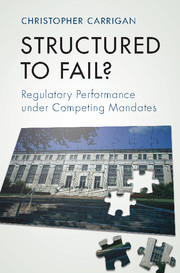Book contents
- Structured to Fail?
- Structured to Fail?
- Copyright page
- Dedication
- Contents
- Figures
- Tables
- Acknowledgments
- 1 Linking Regulatory Failures to Organizational Design
- Part I Examining the Performance of Multiple-Purpose Regulators
- Part II Assessing the Role of Regulatory Agency Design in the Gulf Oil Disaster
- Part III A Theory of Multiple-Purpose Regulators
- Book part
- References
- Index
- References
References
Published online by Cambridge University Press: 04 July 2017
- Structured to Fail?
- Structured to Fail?
- Copyright page
- Dedication
- Contents
- Figures
- Tables
- Acknowledgments
- 1 Linking Regulatory Failures to Organizational Design
- Part I Examining the Performance of Multiple-Purpose Regulators
- Part II Assessing the Role of Regulatory Agency Design in the Gulf Oil Disaster
- Part III A Theory of Multiple-Purpose Regulators
- Book part
- References
- Index
- References
- Type
- Chapter
- Information
- Structured to Fail?Regulatory Performance under Competing Mandates, pp. 288 - 307Publisher: Cambridge University PressPrint publication year: 2017



